
The aquatic gardens
“What a beautiful pool! Its view, its beauty
Illuminate the mansions.
Its beauty is such that, might it be categorized,
must take the first place, and the sea the second.
The immense gardens can do without
clouds stripping off their waters”.
(So described the Arab poet Al-Bahturi (820-897), born in Aleppo (Syria), the aquatic gardens of the Abbasid Samarra Palace in the times of Caliph al-Mutawakkil).
From the most legendary eastern paradises up to the latest designs of modern gardens, many have been the changes that have taken place in the art of floral arrangements. However, there is an omnipresent element in most of the styles, as well as in the philosophy of its artistic principles: water, the liquid element, which the great master of the Renaissance, Leonardo da Vinci, did not hesitate to describe as “the sap of nature”.
As in many other issues, China was a forerunner regarding garden design. Once the emperor Wu of the Han dynasty (206 BC-220 AD), hence the contemporary of Imperial Rome, once concluded the difficult task of unifying the vast country, he conceived the creation of an Eden to be immortal, a space where the mist from the North, the transparency of the southern valleys and the wonderful central mountains of the country would be present. What happened was that, since he could not recreate such mountains and ranges in reality, he decided to do it through fantasy. In this way, he built the garden-lake-island that has been copied, after several variations, over and over, both in China and Japan. In Wu’s garden, rocks accurately stood in for mountains, streams for the rivers, bonsais for the enormous trees, and the lake for the sea. Without trying, Wu laid out the principles of Chinese art of gardening.
Japan, one of the most exquisite countries of the world, knew how to formulate the wonderful designs of the Chinese art of gardening, adapting them to its own philosophy of vitality. Japan incorporated its peculiar geology of volcanic mountains, whose slopes were covered by trees and its snowy craters. These gardens were as rich in plants as the Chinese ones, but they included the beauty of the element of fire (volcano) in addition to a milder climate. Kyoto was the capital of the Heian period (794-1185). According to the accounts of Genji (from the author Murasaki Shikibu, who wrote the first novel strictly speaking of literature history), it seems that the place was chosen for its singular beauty as a recreational space rather than as the seat of government. The city was surrounded by forested hills and one hundred streams flowing down, splashing its numerous gardens, sprinkling them with the rumors of their waters. Heian’s court’s favourite pastime was boating in the lakes of the gardens, writing poems dedicated to flowers, selecting stones and designing waterfalls, even sitting the whole morning looking the undulating form of the smoke of a fire used to burn the stubble resulting from the trimming, or feeding the fishes. Unfortunately, none of those legendary gardens remain. Yet, in the year 1894, on the occasion of the commemoration of the 1,100 anniversary of the city of Kyoto as the capital of the ancient country of the Rising Sun, a reconstruction of one of them was made: the Heian sanctuary, one of the more cheerful and best designed gardens of the world, with plenty of cherry orchards, flower beds of azaleas, water lily islands, and huge expanses of irises. The Genji’s spirit is here indeed.
Colours.
Pascual Timor. ©Fundación El legado andalusí.
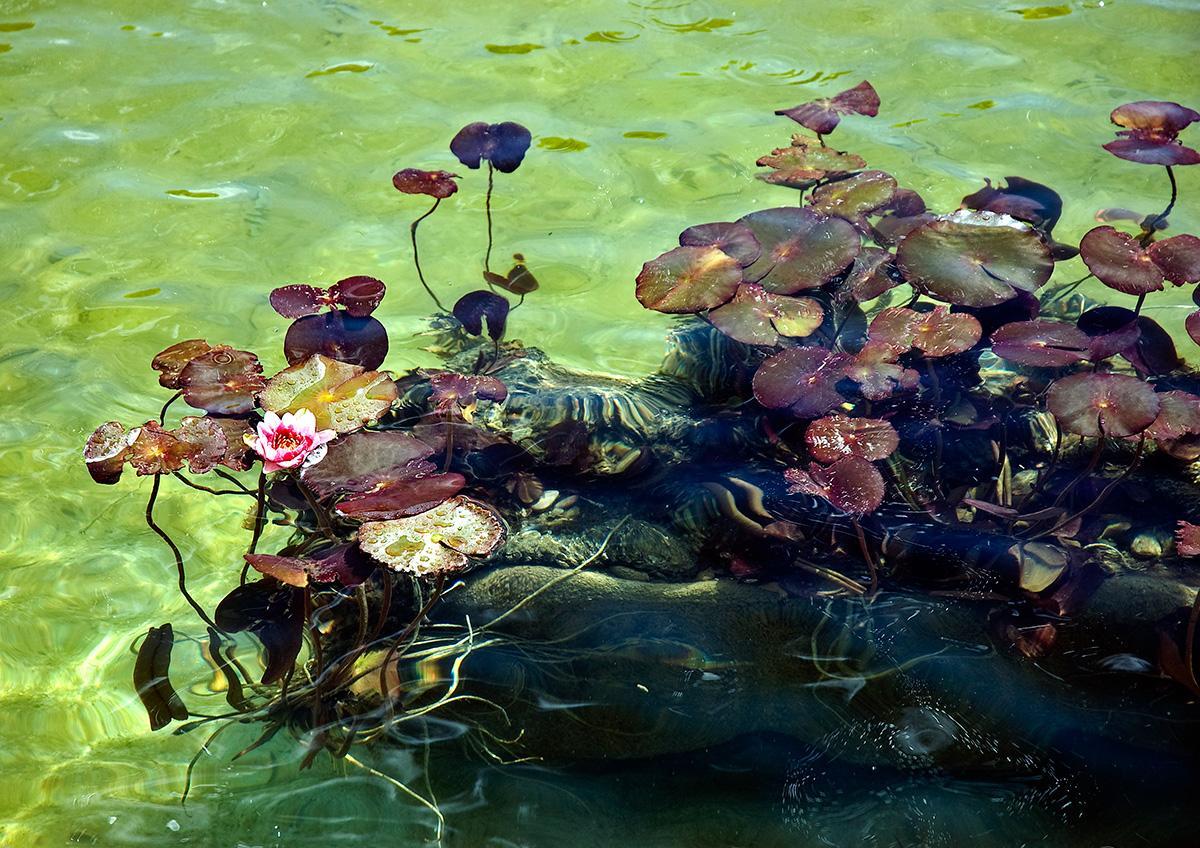
From the farthest East, across the legendary Silk Road, the art of gardening reached the doors of the West, specifically Persia, a crossroad between India and the Mediterranean Sea, the cradle of one of the greatest mystics and philosophers of humanity, Zarathustra (Zoroaster in Greek, meaning “the one of the golden light”, founder of the Mazdeism, and the driver of duality, as antagonistic forces: Good and Evil; the first representing the soul, the spirit, and the second the body, the matter).
Courtyard of Casa de la Contratación, Seville.
©Xurxo Lobato. Fundación El legado andalusí.
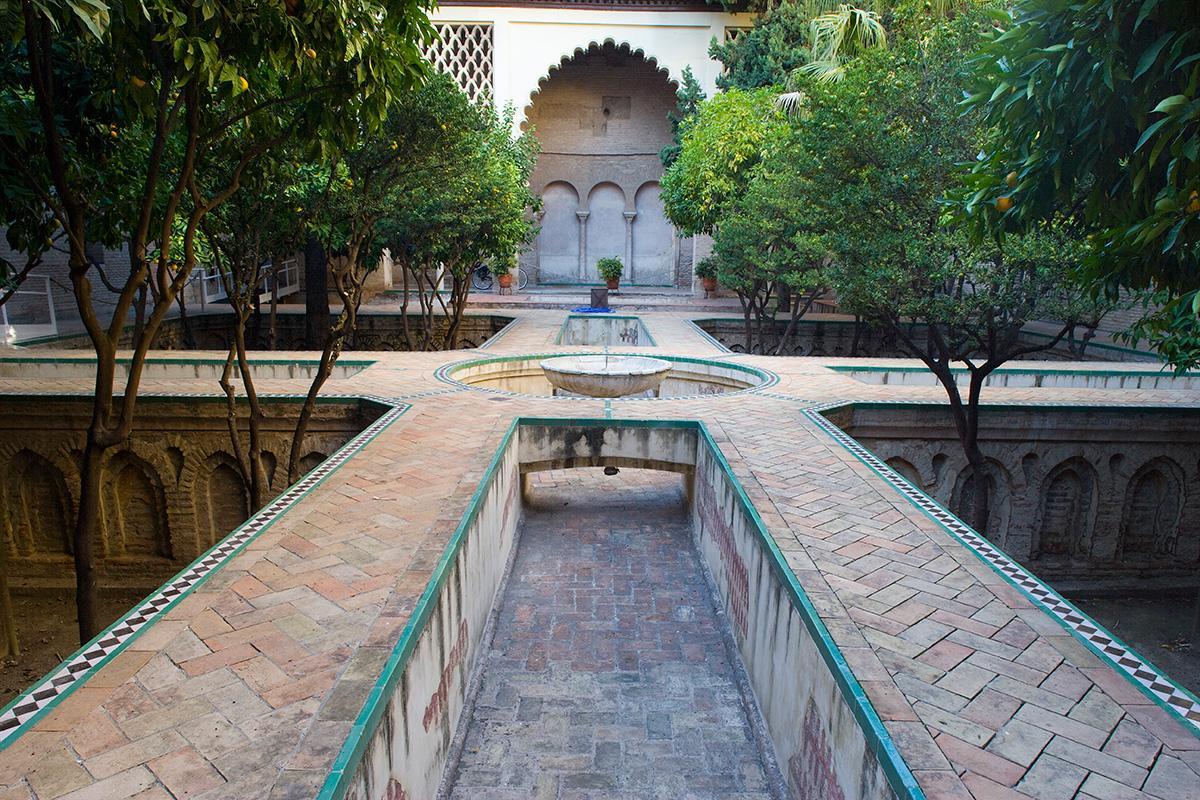
Persians have played an important role in the history of gardening. No other culture has developed such a fascination for gardens. American archaeologist and historian Arthur Upham Pope (1881-1969), specialist in Persian art, described it accurately: “In Persia, the need to own a garden is deeply rooted; it is more articulated, more universal than the passion of Japanese for flowers or the linking for countryside of English.”
Arthur Upham was enraptured contemplating the famed botanic and architectural complex of Narenjestan-e Qavam, where he did not hesitate in establishing the Asian Institute. It was a paradise on earth he defined this way: “It is a fascinating garden, a pleasure for the senses; trees and flowers release their fragrance and beauty in the atmosphere with their exquisite scents, beautiful and poetic. Within this garden –whose name recalls that of the bitter orange– a building of nice and balanced architecture rises. It is one of the most extraordinary artistic works made by the builders from Shiraz, designed by Ebrahim Khan-e Qavam in the 19th century. A walk across the garden becomes the most agreeable experience, for we can contemplate, at the same time, a work of art that is seldom repeated by human beings”. Since 1998, the Narenjestan-e Qavam has been part of the College of Art and Architecture of the Persian city of Shiraz. The extreme aridity of Persia and its merciless sky has made of gardens, with their high walls, the shade provided by their trees and the air cooled by their streams and fountains, the simplest expression of paradise. In fact, the promise of Eden made by Muhammad in the Koran describes precisely how black-eyed Houris (hūr) of “splendid beauty, glowing youth, virginal purity and exquisite sensibility” will arrive to a garden pavilion under the shade of palm trees and pomegranates, near streams not only of water, but of milk and honey In its origins, the word “paradise” meant a hunting park, but it is still used in Persia to name a garden. The plan of a Persian garden continued to be strictly formal, a modified version of the Egyptian plan, normally in the shape of a cross (Greek or Latin). Two main channels divided the garden into four areas which represented, as it was said, the four elements or dwellings of the Universe. In the centre, where the channels or rivers met, there used to be a pool for surplus water, coated with blue tiles to enhance the freshness of water. In the gardens of bigger proportions, there were hundreds of subsidiary water channels which divided and subdivided the terrain over and over. Small jets allowed water not only to be seen, but also heard.
The Arabs, apart from preserving classical culture (Greece and Rome) were also transmitters of the great cultural and scientific heritage of the East.
Hispanic-Muslim civilization, to which we owe much debt, meant the transfer to the Iberian Peninsula —from the year 711 until 1492— of the essence and creative abilities of the Muslim world through land and sea routes from the main centres of Samarkand, Persia, Aleppo, Damascus, Alexandria, Constantinople, Baghdad, Arabia, etc. And the garden was one of the many inheritances we received from them, closely linked, paradoxically, to desert and heat. That is the reason why, following the teachings of the Koran, believers should be offered an advance of paradise –and this was the garden. Yet, Islamic gardens could not be understood without water: pools, channels, ponds, fountains… all of them outfitted with a complicated system of hydraulic engineering –both in private and in public gardens– which ensured that water flowed from one level to another through cascades, if the level was downstream, and by waterwheels and mills if the level was upstream. All in all, it comprised a spatial setting of stunning beauty, balance, volume and shape.
Hispanic-Muslim palaces are considered among the most beautiful of Islamic civilization of all times; in this sense, Cordoba first, and then Granada have much to say. Almost every medieval poet described such paradises. Ibn Sai’id, the Sevillian poet from the 13th century, in his work The book of the banners of the champions, explained the charm of the aquatic gardens of Al-Andalus with sentences like: “Beautiful fountain that stones the sky with wandering stars, jumping like agile acrobats! Serpents of water gush from the fountain, rushing toward the bowl like frightened vipers. Because water, accustomed to sneaking furtively under the earth, when discovering an open space, fastens the pace to flee. Later, however once rested and satisfied with its new home, smiles proudly showing its bubble teeth. And then, when the smile has uncovered its delicious teeth, the branches in love soon bend down to kiss it”.
Generalife.
©Fundación El legado andalusí
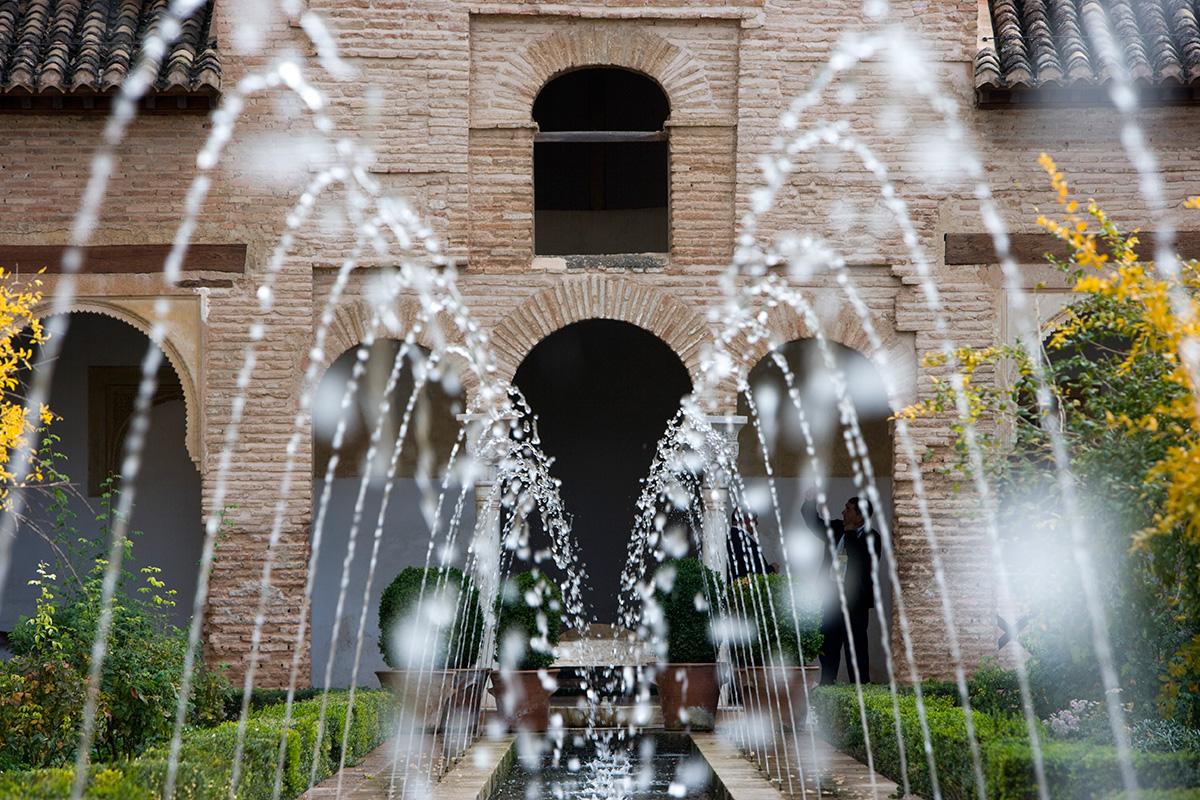
One of the most legendary gardens of the Granadian, or Nasrid culture was the vizier Ibn al-Khatib’s residence, located on the outskirts of the city of the Alhambra. The place had a poetic name: “Fountain of tears”; writers from the 13th and 14th centuries –like Ibn Khatima– never tired of describing the spell of this Eden: “Is it perhaps the sky or is it otherwise a construction in which stars rise up, obscuring the real stars with their height? Its shapes are facing each other and look as if they were the center and sides of its necklace. The water flow on it, forming long tails that resemble comets. It rises on top of a pavilion surrounded by glass skylights of proportioned forms. The myrtle around gets wet with water like a smiling mouth or a blooming moustache. There you will find majesty everywhere, in the middle of which a garden and its towers glow.” Many were the landscaped areas spread all over Al-Andalus; we recall the al-Zayyali’s gardens in caliphal Córdoba, an inviting site for dialogue and creativity, shaded by palm trees and pomegranates and lemon trees; the Arruzafa gardens, also in Córdoba, designed by Abd-er-Rahman I; those in Madinat al-Zahra, only seven kilometres from Córdoba, a whim that Abd-er-Rahman offered to his favourite Zahra; the king al-Maimun’s, in the city of Toledo; the al-Mutamid’s, the poet-monarch from the kingdom of Seville… Yet, one of the best examples of aquatic gardens inherited from the Hispanic-Muslim civilization can be found in Granada: we are referring to the Generalife (the Nasrid monarchs´ recreational summer residence). There, the essence of paradise is combined as nowhere else: broad avenues covered by trees, dotted by bushes which preserve ponds of all sizes and shapes, which connected with the ditches that fed at the same time round basins of fountains with lobed edges. Every now and then, jets of crystalline water try to match the height of tall plants (orange and lemon trees, jasmine, geraniums, laurel, and all kinds of scented wildflowers which freshen the air). There are many intimate spaces equipped with benches which invite to rest and inspiration; behind all this rapture of beauty, the rumour of water flowing everywhere… In the Alhambra, in the gardens of the Court of the Myrtles (Patio de los Arrayanes), the great architectural volumes duplicate by being mirrored on the translucent surface of the pond’s lagoon. In the Partal Gardens –also in the ensemble of the Alhambra– the Tower of the Ladies (Torre de las Damas) also looks itself on an aquatic mirror, while being observed by the lion-jet which seems to be the guardian of its beauty.
Water is present in all manifestations of life in Islamic culture.
“Al-Ándalus salpicado”.
Alberto Albaladejo. ©Fundación El legado andalusí.
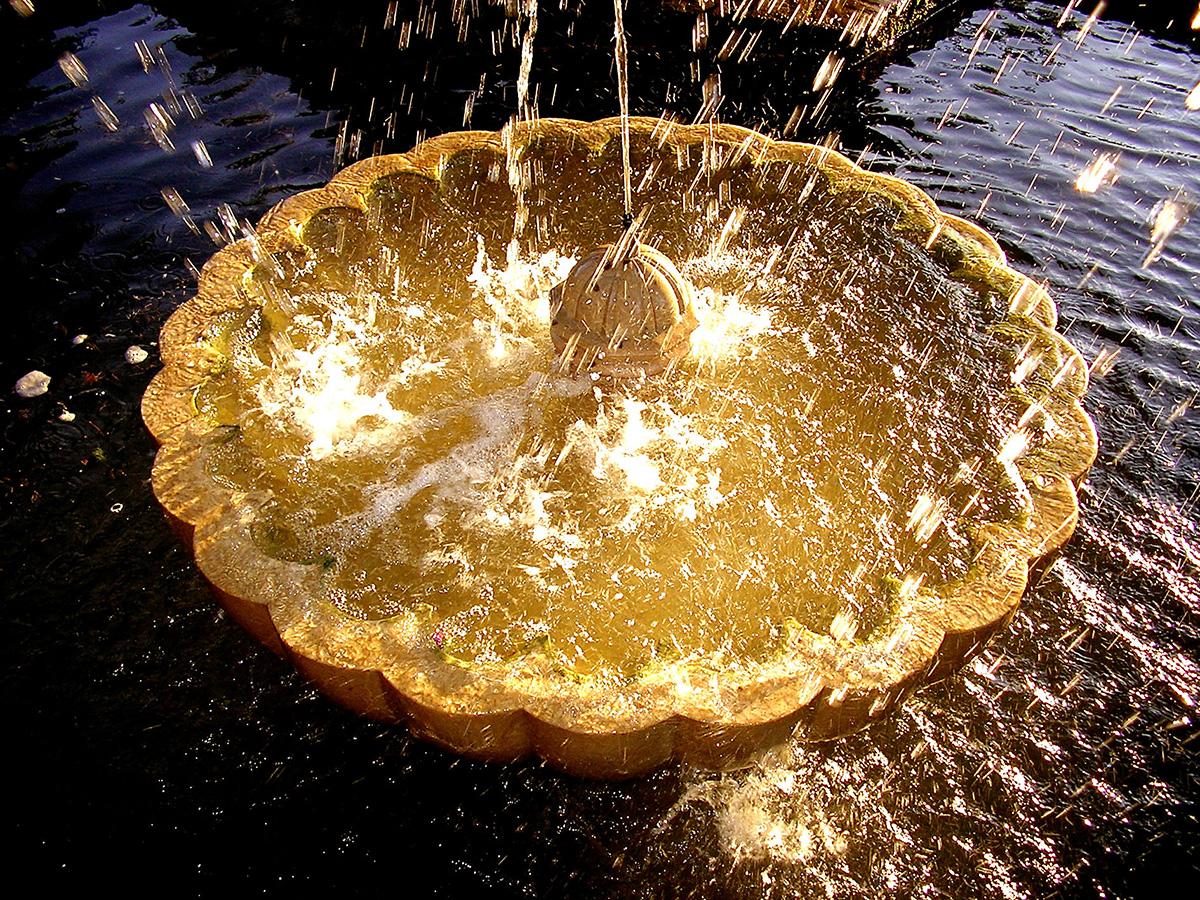
Proof thereof is that there is no difference between religious and civil art in the Muslim world: a room is at the same time a place of prayer, where the same rituals as those performed in a mosque can take place. . “The water basin in my center resembles the soul of a believer, sunk in the memory of God”, reads an inscription in the Ambassadors or Throne Hall, in the Comares tower of the palace complex of the Alhambra of Granada. The very Court of the Lions, a real anticipation of paradise on earth, is in the same way a space where water has its specific significance, not because of its abundance, but for the impact of its clamour, its rumour echoed when the sound bounces as it reaches the four spatial dimensions of this unique courtyard, which was also conceived by its Nasrid creators considering the esoteric Golden Ratio (1.617). The Court of the Lions was at the beginning an hortus conclusus, a totally finished garden surrounded by walls (four arcaded galleries), and as every Eden of this kind, it is about the philosophical and religious conception of Islam, an image of paradise, whose Koranic name al-yanna includes, at the same time, two of the meanings of “garden” and “hidden place”. In order to comprehend such a profound assertion, we need to imagine the spaces between the four water currents, now covered by sand in the fashion of small flower beds or small channels covered by flowering shrubs and all types of aromatic plants. That is the reason why the Court of the Lions follows accurately the metaphysical spirituality of the Islamic paradisiacal garden, and also includes the four rivers of the Islamic Eden, whose waters flow towards the four cardinal points, or departing from them to the center, an area where the very essence of the human being would be represented. Something similar also happens in the labyrinths created by the Templar knights, which believers, as initiated in the science of knowledge, must walk in silence and barefoot, so as to become aware through their own inner consciousness of the power of Mother Earth. According to Muslim spirituality, these rivers are the veins of knowledge which take the believer to the centre, that is to say, to their own being. Water currents of the Court of the Lions come from the rooms which open to the courtyard north and southwards, and under the stone baldachin east and west.
Besides, to compensate for the existing slope between the levels of the architectural sections of this sacred ensemble, we should bear in mind that the floor of the rooms is at a higher level than that of central garden, so as to allow water to flow towards the center after having rested in the round basins of lobed edges. Then, it keeps on flowing to the center, running until the galleries’ doorsteps and, without pause, getting to the spatial center: the fountain. “If someone washed himself in one of its basins, water would always remain clear and pure”, exclaimed Titus Buckhardt, one of the great specialists in Nasrid art”
Partal Gardens, Alhambra, Granada.
©Xurxo Lobato. Fundación El legado andalusí.
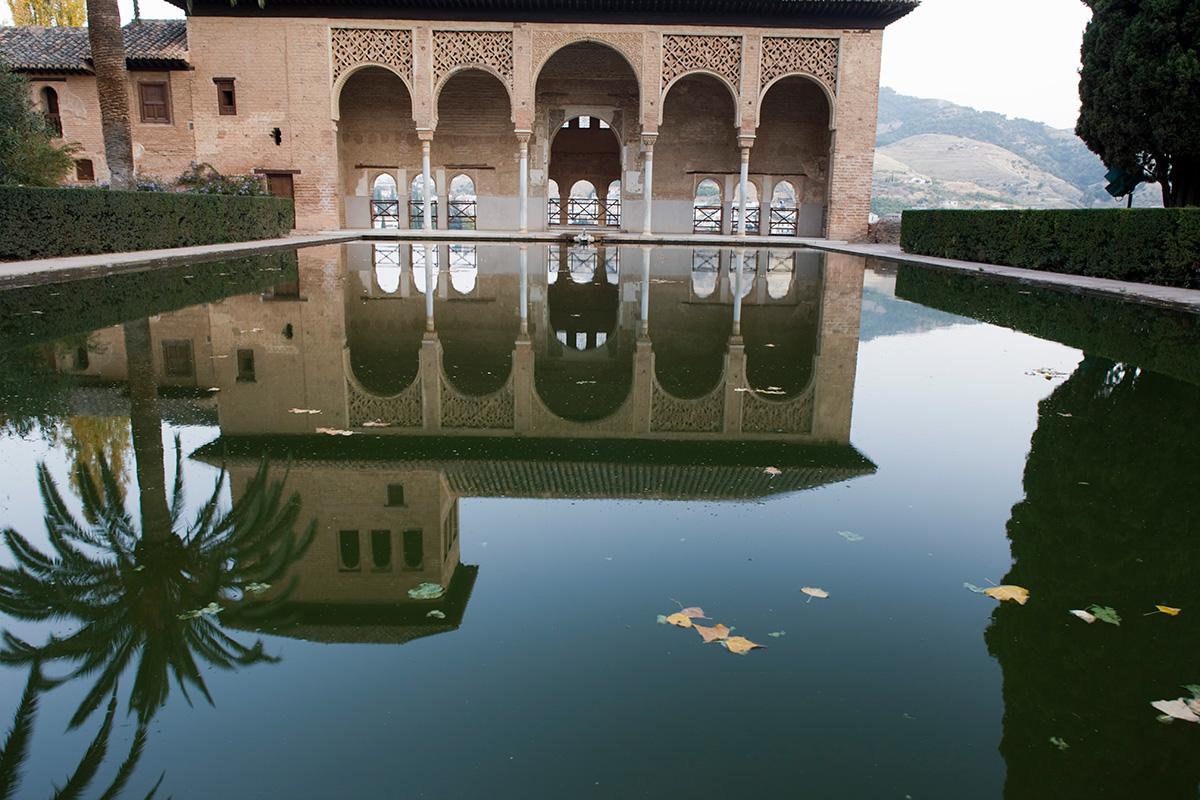
The fountain itself, with its twelve lions which support a basin and throw water out of their mouths, is a very old symbol that arrived to the capital of the last Muslim kingdom of the West, to the palace of the Alhambra, in the city of Granada, from Persia and the imperial cities of the Routes of the Silk in the East. For the lion throwing crystalline water out his mouth is no other but the sun king, from which life flows. The twelve lions symbolize the twelve suns of the Zodiac, the twelve months which, in eternity exist all together simultaneously. Old stories tell that these noble animals, immortalized in beautiful stone sculptures and whose bright colours are been restored by skilled hands, are responsible for holding the sea: the same mission that was charged to the twelve bulls of the first Temple of Solomon (whose design and construction was accomplished by the most legendary of all architects in ancient times: Hiram), this sea being the celestial waters tank. This leads us to wonder to what an extent were the builders of the Alhambra’s fountains still aware of this symbolism, twenty-eight centuries after Hiram, a question that we might know some day. The same happens with the two baldachins, identically porticoed, along the longer sides (the ones to the East and West) of the Court of the Lions’ rectangle, which confirm the conception and model of the heavenly garden, whose main features are those baldachins (rafraf), or tents, which give us a closer idea of the Muslims’ traditional life in the desert. In fact, in these palaces, the gabled and hipped roofs recall the “awnings” of the desert caravan canvasses that seem to be floating on the stylized columns crowned by delicate and beautiful capitals. If there is a place where we can appreciate Islamic art with such a vibrant and analogical connotation to purest Persian art that is the ensemble of the Alhambra.
This shocking representation of heavenly Eden is due not only to the whispers of water, whose rumours hang over the spirit of those who have the good fortune to gaze upon such a beauty, but also to the scent of flowers, and wild or cultivated aromatic plants, as well as the delicious birdsongs. Is there a more striking and vital setting in the world that can overshadow the Alhambra? And if on top of it we add the spatial balance of a crystalline architecture, then the true paradise has at one time both properties: the fullness of life and the unchangeable nature of crystal. It is easy to come to the conclusion that the Alhambra is the unattainable wholeness of spiritual beauty, a place where people reach the fullness of the sacred dimension and the soul is projected toward the infinite. According to Sufi philosophy, paradise has been created out of the divine light, as from light was also conceived this citadel in the air –which crowns the Sabika hill, one of the seven hills that surround Granada– for the forms of the Hispanic-Muslim architecture, the arabesque friezes, the nets engraved on the walls, the muqarnas (“talking” stalactites under the arches) which exist not only by themselves, but as manifestations of the nature of light. The most intimate secret of this art, as spiritual as it is material, is an alchemy of light, since as true alchemy, its purpose is “turning the body into spirit and the spirit into body”; the Nasrid art, in its 260 years of history and cultural development, was able to dissolve the solid body of the building into a whole of vibrant light, at the same time turning light into motionless glass, its alarifes (builders)acting as expert alchemists and finding in the Alhambra the crucible of the philosopher’s stone, which, in this case, is no other than the liquid element, wisely applied to the whole of the four elements that make up the Islamic garden in general, and the one of this alcazaba in particular.
Leonardo da Vinci, as in other subjects, was a forerunner regarding the concept of residential gardens: his best designs are located in the idyllic Loire Valley –the region where he lived his last four years of life as a guest of the French monarch Francisco I, who was his patron. This genius of the Renaissance created the fluvial chateaus where troubled waters helped both to protect the venue and to conduct it through channels which fed the garden ponds and water fountains. Yet, the most significant examples of Renaissance aquatic gardens are somewhat belated, and the most important ones are in Italy. Without doubt, the most impressive of these creations is Villa d’Este (built in Rome between the years 1550-1580), where the exuberant waters convey with joy the extroverted spirit of its time; its fountains shape impressive cascades, generating deafening echoes in a framework where sculptures take part also in that fantastic stage. Water, hence, had a crucial role in the Renaissance gardens. It was associated with fertility and proliferation in nature.
Jesús Ávila Granados, writer.

